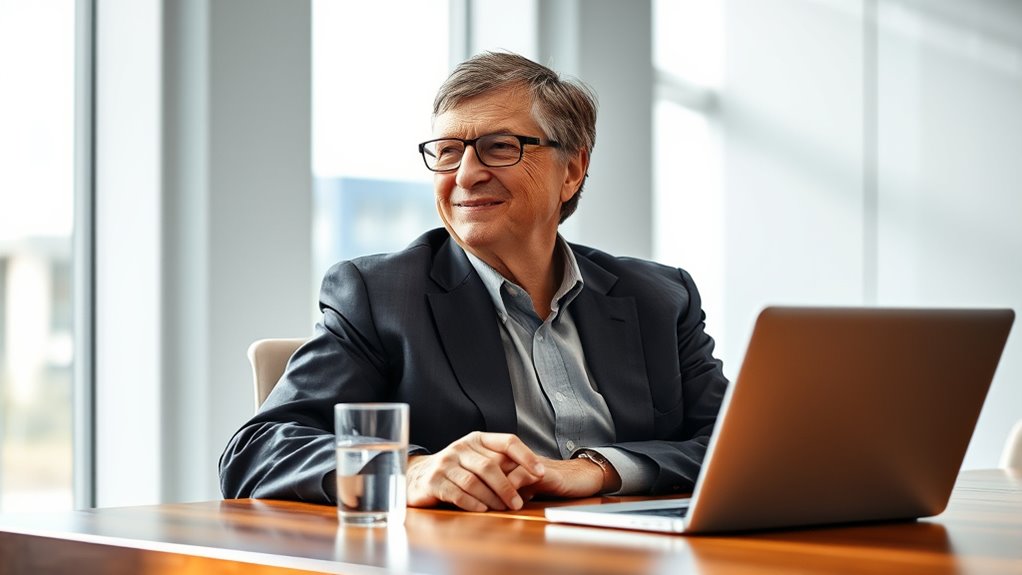Bill Gates co-founded Microsoft, revolutionizing personal computing with software like Windows and Office. He led the company to dominate the tech industry before stepping down as CEO to focus on philanthropy. Through the Gates Foundation, he’s donated billions to improve global health, education, and reduce poverty. His influence extends beyond business, shaping innovations and advocating for societal progress. If you’re curious about his journey from tech pioneer to global philanthropist, there’s more to explore.
Key Takeaways
- Co-founded Microsoft in 1975, revolutionizing personal computing with software like MS-DOS and Windows.
- Led Microsoft to become a dominant global technology company through innovative products and strategic partnerships.
- Faced legal challenges over antitrust practices but contributed to industry regulation and fair competition.
- Established the Bill & Melinda Gates Foundation, donating over $102 billion to global health and education initiatives.
- Transitioned from business leadership to philanthropy, focusing on health, poverty reduction, and sustainable development worldwide.
Early Life and Education

William Henry Gates III, known as Bill Gates, was born on October 28, 1955, in Seattle, Washington. As the second of three children, he grew up with an older sister, Kristianne, and a younger sister, Libby. His father, William H. Gates Sr., was a successful lawyer, and his mother, Mary Gates, was a teacher turned community volunteer. From a young age, you would notice Bill’s curiosity and love for reading, especially encyclopedias and reference books by age 8. His early academic strengths lay in math and science, though he sometimes found school boring. To challenge him further, his parents enrolled him at Lakeside School when he was 13. There, he discovered computers, programming, and began developing software, setting the foundation for his future success. During his time at Lakeside, Gates also cultivated an interest in early programming languages, which helped develop his problem-solving skills and passion for technology.
Founding and Growth of Microsoft

Microsoft was founded on April 4, 1975, by Bill Gates and Paul Allen in Albuquerque, New Mexico, with the goal of developing software for the emerging microcomputer market. Their first product, Altair BASIC, was an interpreter for the BASIC language, created in just eight weeks, and they secured distribution rights after demonstrating it to MITS. The company’s name, “Micro-Soft,” was coined by Allen and later became Microsoft. Initially small, they moved to Bellevue, Washington, in 1979 to expand their talent pool and incorporated in 1981. Their partnership with IBM in 1981 led to MS-DOS, which became the industry standard for PCs and set the stage for Microsoft’s dominance. By the mid-1980s, they began developing Windows, further strengthening their position in the software industry. The company’s growth was driven by innovations in software technology and their ability to adapt to changing market needs.
Leadership and Business Achievements

Bill Gates’s leadership style transformed from autocratic to visionary and empowering, enabling Microsoft to innovate and grow rapidly. You, as a leader, focus on inspiring teams by aligning the company’s vision with personal goals, fostering a culture of creativity and risk-taking. Delegating responsibility to leadership teams allows strategic focus and encourages autonomy among employees, promoting critical thinking and ownership of projects. Gates’s visionary yet pragmatic approach balanced ambitious goals with feasible execution, motivating employees through passion and dedication. He prioritized hiring top talent and trusting teams to deliver results while maintaining open communication and collaboration. Viewing setbacks as learning opportunities, he promoted resilience and continuous improvement. Through mentoring and fostering an ownership mindset, Gates built an innovative, adaptable organization that achieved remarkable business success. Incorporating essential oils in wellness strategies reflects a holistic approach to health, emphasizing the importance of natural remedies.
Legal Challenges and Controversies

You might wonder how Microsoft’s dominant market position led to major legal battles, shaping its future. The antitrust lawsuits accused the company of using unfair tactics to maintain a monopoly, impacting both competitors and consumers. These legal challenges forced Microsoft to change its practices and set important precedents for regulating big tech firms. The case also highlighted the challenges of applying traditional antitrust laws to rapidly evolving high-tech markets like software and internet services. Additionally, the legal scrutiny prompted the company to adopt more transparent business practices, influencing industry standards and regulatory policies.
Legal Monopoly Concerns
Concerns over Microsoft’s dominant market position have led to intense legal challenges centered on its bundling practices and restrictions on original equipment manufacturers (OEMs). By bundling Internet Explorer with Windows 98, you were effectively reducing competition from rivals like Netscape Navigator. This “tying” practice violated the Sherman Antitrust Act, making it hard for consumers to choose alternative browsers. Microsoft also imposed restrictions on OEMs, limiting their ability to remove Internet Explorer or install competing software, aiming to maintain its monopoly. Legal proceedings uncovered internal strategies to suppress competition, including coercive tactics against rivals like Netscape and Java developers. These practices prompted legal actions focused on monopolization, resulting in settlements that required Microsoft to modify business practices, promoting fairer competition without dismantling the company. The case revealed evidence of intentional efforts to eliminate competition, which further intensified regulatory scrutiny and public concern. Ongoing investigations continue to examine how such practices impact market fairness and consumer choice in the technology industry.
Antitrust Lawsuits Impact
The antitrust lawsuits against Microsoft marked a pivotal moment in its history, exposing the company’s aggressive tactics to maintain its monopoly. You saw how the DOJ and 20 states accused Microsoft of coercing manufacturers to pre-install Internet Explorer, harming competitors like Netscape. The trial, led by Judge Jackson, revealed Microsoft’s intent to “extinguish” rivals and use its dominant Windows OS to unfairly promote Internet Explorer. Although the initial ruling called for breaking up the company, a settlement was eventually reached, imposing behavioral restrictions. These legal challenges pushed Bill Gates to step down from his leadership role and shifted Microsoft’s focus away from innovation and market expansion. The case also heightened public scrutiny on tech giants’ market power, shaping future antitrust enforcement. Additionally, the case had a lasting impact on how technology companies strategize to avoid similar legal issues in the future. Recognizing the importance of store hours and operational transparency, companies have since adjusted their practices to maintain regulatory compliance and consumer trust.
Philanthropy and Global Impact

How has Bill Gates’s philanthropy transformed global health and development efforts? With a $77 billion endowment, the Gates Foundation directs over $102 billion in total grants, focusing heavily on health initiatives. Your contributions, along with Warren Buffett’s, have helped fund programs to reduce child and maternal mortality, combat infectious diseases like polio, and promote gender equality. The foundation’s investments in data collection and analysis have led to significant declines in child mortality since 2000. By filling funding gaps left by governments, it’s become a global leader in health efforts. Its strategic approach has also influenced global health policies and priorities through strategic partnerships and advocacy efforts. Gates’s strategic plan aims to sunset the foundation in about 25 years, ensuring that resources are used efficiently to eradicate major diseases and improve lives worldwide. Your support drives impactful, data-driven change across the globe.
Wealth, Recognition, and Legacy

Your view of Bill Gates isn’t complete without recognizing how his wealth has shaped his influence and reputation. His industry leadership and cultural impact extend beyond Microsoft, cementing his status as a global icon. As his legacy continues through philanthropy, it prompts you to reflect on how wealth can drive lasting change. As of April 2025, Gates’ estimated net worth is around $106.5 billion, reinforcing his position among the world’s wealthiest individuals. His philanthropic efforts, notably through the Bill & Melinda Gates Foundation, exemplify the power of wealth to effect lasting social change.
Wealth Accumulation and Status
Bill Gates has built an extraordinary legacy through his remarkable wealth, recognition, and influence. His initial wealth surged after Microsoft’s 1986 IPO, and today, his net worth ranges between $106.5 billion and $116.6 billion. Despite holding less than 1% of Microsoft, valued at around $28.6 billion, most of his wealth now stems from diversified investments, including biotech and AI startups. His prominence is reflected in titles like the world’s richest person multiple times and being the youngest billionaire at 32. The table below highlights his status:
| Wealth Source | Recognition | Legacy Impact |
|---|---|---|
| Microsoft stake | Forbes rankings: 13th | Leading tech industry innovation |
| Philanthropy | Youngest self-made billionaire | Foundations supporting global health |
| Diversified investments | Recognized for philanthropy | Influential business figure |
His wealth and status are integral to his lasting influence, with ongoing efforts to advance global health further amplifying his impact.
Industry and Cultural Impact
Founded in 1975, Microsoft revolutionized the tech industry by pioneering personal computing software that transformed how people and businesses use technology. You see, by developing MS-DOS in 1980 and Windows from 1985, Microsoft became the dominant platform for PCs worldwide, shaping modern digital life. Through strategic partnerships like IBM and innovative practices such as software bundling, Gates’s leadership set industry standards and influenced global markets. His focus on enterprise solutions and productivity tools like Microsoft Office embedded software into daily work routines, expanding the company’s reach. His emphasis on software innovation played a crucial role in maintaining Microsoft’s competitive edge in the evolving tech landscape. Culturally, Gates became a symbol of Silicon Valley‘s entrepreneurial spirit—initially seen as a tech prodigy, then a strategic business leader. His legacy continues to influence industry standards, digital literacy, and the evolution of cloud computing and AI. Microsoft’s dominance also paved the way for the growth of the software industry and the development of new digital ecosystems around their products.
Ongoing Philanthropic Influence
Have you ever wondered how a billionaire’s wealth can be channeled into global change? Bill Gates has transformed his fortune into powerful philanthropic efforts, pledging to give away nearly all of his wealth through the Gates Foundation over the next 20 years. His net worth, now around $124 billion, has decreased by nearly 30% in 2025 due to his rapid giving. As of 2024, Gates and Melinda French Gates donated over $60 billion, with Warren Buffett contributing $43 billion. The foundation has granted $77.6 billion for global health and poverty reduction, focusing heavily on Africa. Gates’ influence extends beyond money—shaping global health policies and inspiring other billionaires. His planned foundation closure by 2045 ensures his legacy of systematic, impactful giving.
Influence on Technology and Innovation

Bill Gates’s influence on technology and innovation is vast, shaping the way millions access and utilize digital tools. His vision of democratizing personal computing led to breakthroughs that transformed everyday life. You benefited from the development of MS-DOS and Windows, making computers more accessible with user-friendly interfaces. Microsoft’s software standards, like Office, set industry benchmarks, boosting productivity worldwide. Gates’s leadership in internet technologies, including Internet Explorer, helped mainstream online access. His strategic foresight into AI, cloud computing, and cybersecurity guided Microsoft’s evolution, influencing global tech trends. He also co-founded Microsoft in 1975, which was pivotal in establishing the personal computer industry. Through these innovations, Gates helped create a digital landscape that empowers individuals and businesses alike, laying the foundation for the modern tech-driven society we live in today.
Transition From Business to Philanthropy

How did a successful tech entrepreneur like Bill Gates shift his focus from building a software empire to making a global impact through philanthropy? In 2000, Gates stepped down as Microsoft’s CEO, transferring $20 billion of stock to his foundation. He co-founded the Bill & Melinda Gates Foundation, initially targeting health and poverty. Over time, he dedicated more energy to philanthropy, fueled by Warren Buffett’s large donations.
| Focus Area | Achievements |
|---|---|
| Global Health | Eradicated diseases like polio and malaria |
| Education | Improved access and opportunities |
| Poverty Reduction | Supported sustainable development |
| Gender Equality | Promoted programs for women and girls |
This progression reflects Gates’s commitment to leveraging his wealth for lasting change and global betterment.
Continuing Involvement and Future Outlook

Ever wondered what role Bill Gates still plays in shaping Microsoft’s future? He remains actively involved in advising on emerging technologies, especially AI. His focus is on guiding Microsoft to find a unique niche in AI development rather than chasing broad goals like AGI. Gates emphasizes that:
Bill Gates continues to influence Microsoft’s AI strategy, focusing on niche innovations and strategic differentiation.
- Microsoft should prioritize AI-driven software solutions tailored to specific needs.
- Innovation cycles will accelerate through substantial capital investments and fierce competition.
- AI will be vital in expanding Microsoft’s cloud services and enterprise solutions.
- Success depends on strategic differentiation and fostering a strong culture of innovation.
Though he stepped down from the board, Gates continues to influence Microsoft’s direction through informal advisory roles. His insights help guarantee Microsoft stays at the forefront of technological evolution.
Frequently Asked Questions
What Inspired Bill Gates to Pursue a Career in Technology?
You’re curious about what inspired him to pursue technology. He was fascinated by early computers and programming from a young age, gaining access to cutting-edge systems at school. His passion grew as he explored coding and saw the huge potential for microcomputers. When he read about the Altair 8800, he recognized an exciting opportunity in the emerging personal computer industry. His drive to innovate and solve problems kept him moving forward in tech.
How Did Gates’ Early Programming Projects Influence His Future Success?
Your early programming projects shape your future success by giving you hands-on experience and technical mastery. Building a BASIC interpreter and automating school systems teach you problem-solving and business skills. These projects show you how software can be a standalone business, boosting your confidence and vision. The lessons learned from early ventures also instill resilience, adaptability, and a passion for innovation that drive your continued achievements.
What Are the Main Goals of the Bill & Melinda Gates Foundation?
Imagine a world where every seed of hope blossoms into opportunity—that’s the main goal of the Bill & Melinda Gates Foundation. You work to eradicate extreme poverty and hunger, improve global health, and promote education and gender equality. Your efforts act like a lighthouse guiding vulnerable communities toward brighter futures. By fostering innovation, collaboration, and sustainable development, you aim to turn visions of equality and health into reality for all.
How Does Gates View His Legacy in the Tech Industry?
You see your legacy in the tech industry as a foundation that transformed personal computing and software development. You aimed to make technology accessible and essential for everyday life, driving innovation and industry growth. While you acknowledge some missed opportunities in emerging trends, you’re proud of your role in shaping Microsoft’s dominance and fostering a culture of excellence. Your work laid the groundwork for future advancements and inspired countless innovators worldwide.
What Are Bill Gates’ Current Projects in Climate Change and Innovation?
You’re witnessing groundbreaking efforts in climate change and innovation. Gates is investing in high-risk, high-reward technologies like compact nuclear reactors, geothermal energy, and carbon conversion. He’s supporting test fusion systems aiming for zero-carbon energy, and scaling clean industrial solutions for major emitters. Through Breakthrough Energy, he fosters global collaboration, pushing for policies like carbon taxes. These initiatives aim to revolutionize how we fight climate change and secure a sustainable future.
Conclusion
As you look at Bill Gates’s journey, you see a towering oak rooted in innovation, branching into philanthropy’s vast sky. His story is a river carving new paths through technology and giving, shaping a legacy that lights the world like a lighthouse guiding others through darkness. With each step, he paints a vibrant mural of possibility and hope, reminding you that even the mightiest trees grow from humble beginnings and a vision that reaches beyond the horizon.










